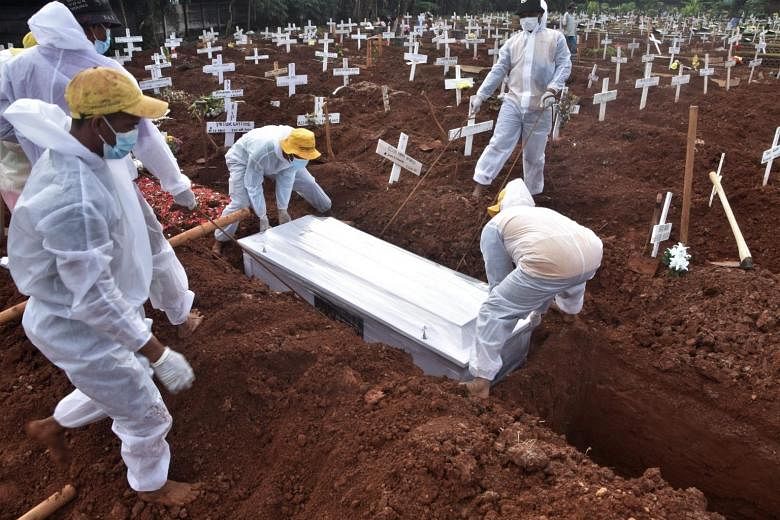Covid-19 deaths across the globe have crossed the 4.4-million mark - officially at least. But a recent study that pegged the excess deaths in India at 4.9 million - over 10 times the government-published toll - has cast doubts on the efficacy of the methods being employed by governments to assess the true extent of the pandemic.
The number of excess deaths is the difference between the annual number of deaths in a specific period and the average number of deaths in the same period in previous years.
Separately, a peer-reviewed study by researchers at Hebrew University in Israel on 105 countries publishing data on excess mortality over the course of the pandemic estimated that there were at least a million more deaths than the official tolls across these nations.
If these excess death figures are considered reliable, that would mean the world has already seen 10 million Covid-19 deaths.
Professor Leo Yee Sin, the executive director of the National Centre for Infectious Diseases, told The Straits Times that "excess mortality is another way to assess the real impact of the disease with an indisputable - death is death - most severe outcome".
"The findings and numbers need to be interpreted and applied in the right context, in addition to understanding the characteristics of the pathogen of concern," said Prof Leo.
"Excess mortality... reflects confirmed Covid-19 deaths as well as deaths that may not have been diagnosed and reported and deaths due to other causes which occur as a result of the Covid-19 outbreak."
Professor John Middleton, the president of The Association of Schools of Public Health in the European Region (Aspher), summed up the dangers of undercounting the deaths in the pandemic. "When you downplay the seriousness of this pandemic, it influences how a country can properly manage the pandemic for their own citizens.
It also makes it difficult to ascertain whether movement curbs are warranted and prevents adequate international controls, he added.
World Health Organisation spokesman Tarik Jasarevic told ST: "Foundationally, every life, and thus death, counts and an absence of accurate statistics is an injustice to those uncounted.
"Considering competing public health priorities at both the global and national levels, the gravity of the impact of the pandemic must not be understated when assessed in relation to other public health concerns."
Mr Jasarevic said accurate monitoring was imperative to assess the success or failure of various responses and a crucial component of developing mitigation strategies that can be used in other contexts of the world as well as in the future.
"As the world pushes for increased equity in vaccine access, the need for timely and reliable data on the impact of the pandemic is critical," he said.
Dr Henrique Lopes, scientific coordinator of Public Health research projects at Portuguese Catholic University, cited Russia as an example of a country where there was high resistance to vaccination due to fudging of Covid-19 data.
"I suppose around 70 per cent of the population is against vaccination. When the population understands the threat and understands what you can receive in protection through vaccination, vaccination numbers explode. When you do not show the full picture to the people, it is much more difficult for them to understand the situation."
Dr Lopes also pointed to widespread fake news that devalued the importance of the vaccination programmes as a consequence of the undercounting of the Covid-19 toll.
He said the excess deaths in the pandemic could be attributed to five factors: inadequate testing capacity for Covid-19; the high cost of testing deterring people from getting checked in poorer countries; political resistance to the publishing of accurate statistics as being "unpatriotic"; deaths due to other ailments that were caused by people unable or unwilling to access overcrowded hospitals; and behavioural problems, such as substance abuse and domestic violence.
"If the official numbers are around four million deaths, probably the real number now is around 10 million direct (deaths)," said Dr Lopes, a senior member of the Aspher board, adding that there was likely to have been an equal number of indirect deaths.
So how does the world come to an accurate assessment of the true toll of Covid-19?
Prof Leo observed that surveillance - both active and passive - is commonly used for situation assessment and systematically tracked over time to monitor the trend. Passive surveillance relies on reporting, whereas in active surveillance, information is actively sought.
She indicated that the undercounting in nations like India could be captured through a combination of both strategies.
"For instance, Covid-19 has a wide range of clinical manifestations, from asymptomatic to severe illness and death. Passive surveillance relies on clinician testing and reporting, mostly covering those who present to the system for testing. Thus, in practical terms, it covers mostly symptomatic cases," she explained.
"Active surveillance, however, can apply sero-prevalence tests on the population of interest over a fixed time point. This will capture the full range of clinical manifestations including asymptomatic cases. From there, one can estimate the under-reported incidence rate."













